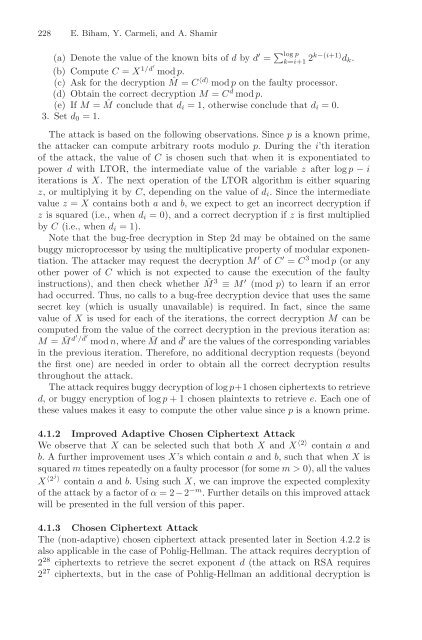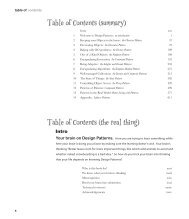rsa-bug-attacks
rsa-bug-attacks
rsa-bug-attacks
Create successful ePaper yourself
Turn your PDF publications into a flip-book with our unique Google optimized e-Paper software.
228 E. Biham, Y. Carmeli, and A. Shamir<br />
(a) Denote the value of the known bits of d by d ′ = ∑ log p<br />
k=i+1 2k−(i+1) d k .<br />
(b) Compute C = X 1/d′ mod p.<br />
(c) Ask for the decryption ˆM = C 〈d〉 mod p on the faulty processor.<br />
(d) Obtain the correct decryption M = C d mod p.<br />
(e) If M = ˆM conclude that d i = 1, otherwise conclude that d i =0.<br />
3. Set d 0 =1.<br />
The attack is based on the following observations. Since p is a known prime,<br />
the attacker can compute arbitrary roots modulo p. During the i’th iteration<br />
of the attack, the value of C is chosen such that when it is exponentiated to<br />
power d with LTOR, the intermediate value of the variable z after log p − i<br />
iterations is X. The next operation of the LTOR algorithm is either squaring<br />
z, or multiplying it by C, depending on the value of d i . Since the intermediate<br />
value z = X contains both a and b, we expect to get an incorrect decryption if<br />
z is squared (i.e., when d i = 0), and a correct decryption if z is first multiplied<br />
by C (i.e., when d i =1).<br />
Note that the <strong>bug</strong>-free decryption in Step 2d may be obtained on the same<br />
<strong>bug</strong>gy microprocessor by using the multiplicative property of modular exponentiation.<br />
The attacker may request the decryption M ′ of C ′ = C 3 mod p (or any<br />
other power of C which is not expected to cause the execution of the faulty<br />
instructions), and then check whether ˆM 3 ≡ M ′ (mod p) to learn if an error<br />
had occurred. Thus, no calls to a <strong>bug</strong>-free decryption device that uses the same<br />
secret key (which is usually unavailable) is required. In fact, since the same<br />
value of X is used for each of the iterations, the correct decryption M can be<br />
computed from the value of the correct decryption in the previous iteration as:<br />
M = ¯M d′ / ¯d ′ mod n,where ¯M and ¯d ′ are the values of the corresponding variables<br />
in the previous iteration. Therefore, no additional decryption requests (beyond<br />
the first one) are needed in order to obtain all the correct decryption results<br />
throughout the attack.<br />
The attack requires <strong>bug</strong>gy decryption of log p+1 chosen ciphertexts to retrieve<br />
d, or <strong>bug</strong>gy encryption of log p + 1 chosen plaintexts to retrieve e. Each one of<br />
these values makes it easy to compute the other value since p is a known prime.<br />
4.1.2 Improved Adaptive Chosen Ciphertext Attack<br />
We observe that X can be selected such that both X and X 〈2〉 contain a and<br />
b. A further improvement uses X’s which contain a and b, such that when X is<br />
squared m times repeatedly on a faulty processor (for some m>0), all the values<br />
X 〈2j〉 contain a and b. Using such X, we can improve the expected complexity<br />
of the attack by a factor of α =2− 2 −m . Further details on this improved attack<br />
will be presented in the full version of this paper.<br />
4.1.3 Chosen Ciphertext Attack<br />
The (non-adaptive) chosen ciphertext attack presented later in Section 4.2.2 is<br />
also applicable in the case of Pohlig-Hellman. The attack requires decryption of<br />
2 28 ciphertexts to retrieve the secret exponent d (the attack on RSA requires<br />
2 27 ciphertexts, but in the case of Pohlig-Hellman an additional decryption is



